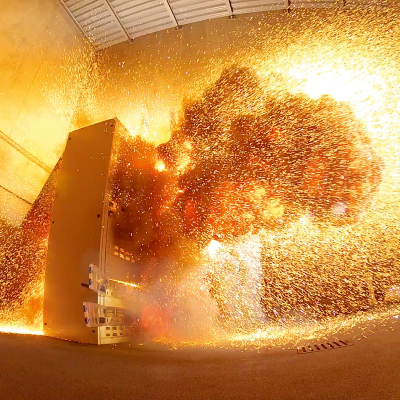DEHN knowledge – Arc faults
An arc fault arises when an electric arc occurs in an uncontrolled manner and in a place where it is not intended. The electric arc can generate high temperatures and cause fires, thus endangering human life. Find out more about the causes, protection against arc faults and choosing the right protection class.
Arc fault: causes and protection

How do arc faults arise?
An arc fault is an unwanted electric arc or spark discharge that occurs between two electrically charged conductors or between a conductor and a conductive material. An arc fault can be caused by interruption or damage to conductors, dirt or moisture, poor connections or loose cables and short circuits. Arc faults can occur in various electrical systems and devices; e.g. in switchgear assemblies, switches, sockets or conductors.

How can I protect myself?
Persons working on or in the vicinity of live electrical equipment are, in principle, exposed to hazards associated with arc faults. It is therefore essential to select suitable personal protective equipment with protective clothing, head and face protection and hand protection against the thermal effects of an electric fault arc.

What protection classes are there?
Personal protective equipment against the thermal effects of an electric fault arcs is divided into two categories: arc fault protection classes 1 and 2. The classes differ in terms of arc energy and incident energy.
For some companies in Germany, two procedures are relevant due to international parent companies. The "open arc test" and "box test" have become established worldwide. Clothing tested with the "open arc test" is classified according to the so-called arc thermal performance value (ATPV, in cal/cm²) or the energy incident limit (ELIM, in cal/cm²). In the box test, there are the two protection classes: arc protection class (APC) 1 and 2. Both methods assume a distance of 300 mm from the source of the arc fault.
The need for and the protection class of personal protective equipment against arc faults is usually determined by the result of a risk assessment.
More on the risk assessmentProtection against arc faults
All-round protection with a system
Comprehensive protection against arc faults follows a clear principle: Firstly, hazards must always be eliminated at their source. If this is not completely possible, further measures must be taken in accordance with the TOP principle – technical, organisational and personal protective measures. Technical measures include active arc fault protection systems and the right tools.
Organisational measures include a regular risk assessment, clear work instructions and complete system documentation. Finally, personal measures, such as wearing personal protective equipment against arc faults, are effective in minimising the residual risk of an arc fault.
To save lives.
Your arc fault protection concept
An arc fault is not a rare phenomenon, it is a hazard which must be taken seriously. It occurs as an electrical gas discharge due to a technical defect, maloperation, impurities or foreign objects in the system. Therefore, for optimum protection in your electrical installations, plan your arc fault protection holistically. This keeps your employees safe when it matters most.
Find out more
Maximum safety for your team
Personal protective equipment against arc faults is required in electrical installations in which there is a risk of arc faults.
Background knowledge on arc fault protection
Which characteristic values make up arc energy?
This is the electrical energy that is expected at a work location (e.g. switchgear) in the event of an electric arc. In addition to the nominal voltage and the short-circuit current, the tripping time of a surge protection device and a factor kp (arc power to short-circuit power) to be specified are also included in the calculation of this energy.
Which characteristic values make up the protection level of the PPE to be used?
The protection level describes up to which arc energy the personal protective equipment offers protection against the thermal effects of an arc fault. In addition to the working distance and the test energy level (protection class) of the PPE, a factor kT (system geometry) to be specified is also included in the calculation of this energy.
This protection level must always be higher than the arc energy to be anticipated at the work location.
Downloads
| Interview | Dealing with the Risks Associated with Arc Faults in Electrical Installations | The “Hierarchy of Risk Control” is intended to help to jointly define concrete measures to prevent arc faults | .pdf 3.8 MB |
Got any questions on arc fault protection?
You can reach our technical support by phone: +49 9181 906 1510.
We are happy to call you back and respond to your queries in detail.